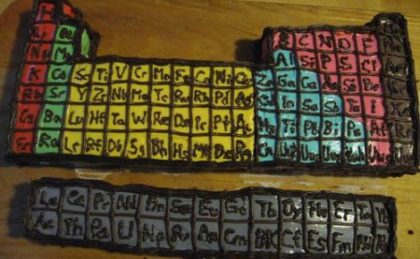
 )
)The periodic table turned 150 earlier this year, or at least March 1 was the 150th anniversary of the publication of Dmitri Mendeleev’s version. Chemists had organized the elements in a tabular fashion previously, and some features (like interactivity!) of contemporary representations would be added later. Still, Mendeleev’s published version was a significant milestone, since he recognized regularities within properties of the elements which suggested some elements with specific features were undiscovered. Even better for his legacy, his predictions held true. Now, a century and a half later, a computer program has relearned what Mendeleev and his contemporaries knew and made some predictions of its own.
The periodic table is a marvel of visualization. You can spend weeks, possibly semesters in chemistry classes before you need to know something about an element that is not encoded in its structure or captured by its data. An appreciation for how atoms are composed from protons, neutrons and electrons illuminates much about why the periodic table works the way it does, but it would be more than 40 years after it was published before physicists discovered those atomic details. A few more years were needed to learn how quantum physics ultimately dictates those particulars. So the elegance of the table is partly a testament to the elegance of elementary particles and their behavior. At the same time, it also testifies to decades and centuries of carefully laboratory investigation which yielded the numerical data that informed its construction.
While some may feel deflated when considering how many laborious hours are boiled down to a one page grid, such a compact and dense summary of chemical knowledge is a boon to students and professional chemists alike. We should all be as lucky to work in a field whose foundations can be communicated so succinctly. In reality, most academic pursuits must settle for a sprawling literature distributed across dozens or hundreds of journals. Digesting what is already known can be daunting on its own, let alone keeping up with the weekly dose of new papers. By one estimate, scientific output doubles every nine years. In other words, half of everything known is less than a decade old. Well, maybe that’s a little too generous in terms of equating publications with knowledge, but it still gives you a sense for the challenge in keeping up with a field.
And so a collaboration of computer scientists and material scientists set out to write an algorithm that could read the literature for them and distill knowledge from it. The program processed published papers in materials science and, without any explicitly provided chemistry knowledge, learned the relationships among elements represented in the periodic table. It could also propose materials to be tested for certain properties and applications, which were subsequently tested and found suitable.
Now, I don’t think materials scientists need to worry about being replaced by AI any time soon. After all, the program is only as good as the quality of the publications being provided to it. And as I understand the method, someone still needs to pose questions to it; the algorithm doesn’t know what it knows. And most intriguing to me–we may not know what we know either. What else have we already figured out and published but not appreciated because it requires synthesizing information across papers in a combination that no person has actually happened to read? For that matter, what else did this analysis extract from the literature that wasn’t revealed because no one thought to ask?
I also wonder if the unique structure of chemistry that makes the periodic table so successful also makes this machine learning technique work better for chemistry? Do you think it might be able to learn something new in your field? Would you trust a digital assistant to help you sort through the literature?
Don’t forget about the upcoming discussion guide on science and faith topics drawn from a variety of contributors here at the ESN blog. You can find more details and preorder from Hendrickson Publishers.
Andy has worn many hats in his life. He knows this is a dreadfully clichéd notion, but since it is also literally true he uses it anyway. Among his current metaphorical hats: husband of one wife, father of two teenagers, reader of science fiction and science fact, enthusiast of contemporary symphonic music, and chief science officer. Previous metaphorical hats include: comp bio postdoc, molecular biology grad student, InterVarsity chapter president (that one came with a literal hat), music store clerk, house painter, and mosquito trapper. Among his more unique literal hats: British bobby, captain’s hats (of varying levels of authenticity) of several specific vessels, a deerstalker from 221B Baker St, and a railroad engineer’s cap. His monthly Science in Review is drawn from his weekly Science Corner posts — Wednesdays, 8am (Eastern) on the Emerging Scholars Network Blog. His book Faith across the Multiverse is available from Hendrickson.

Leave a Reply